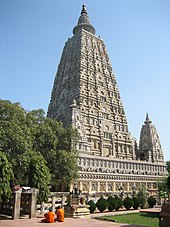Buddhist temple

The Buddhist Temple is a place of the Buddhist religion that unites the so-called Three Treasures , i.e. Buddha , Dharma and Sangha . Buddhist temples differ structurally according to region and comprise a building complex including grounds. In the center there is a sanctuary ( stupa or cult image of the Buddha ). Temples often serve as monasteries for Buddhist monks .
Terms and designations
The European designation as a temple does not reflect the entire concept of the Buddhist temple. In addition to the various buildings, the Buddhist temple also includes the gardens on the temple grounds.
The names of a Buddhist temple in general and the individual buildings in particular differ according to regional traditions and languages. Different names can be used for the temple as a whole.
Examples:
- Chinese: sì 寺 , sìyuàn 寺院
- Japanese ji / dera 寺 , in 院
In Chinese and Japanese Buddhism, different buildings can be differentiated as follows:
- Bell pavilion (Japanese 鐘楼 , shurō / shōrō ) or timpani pavilion ( 鼓楼 , korō )
- Main hall (Japanese 本 堂 , hondō ) or Golden Hall (Japanese 金堂 , kondō ): this is where the main sanctuary (Japanese 本尊 , honzon ) of the temple is located.
- Teaching hall (Japanese 講堂 , kōdō ): Monks gather in the teaching hall to acquire knowledge, to meditate, to perform rites, to invoke Buddha or to recite sutras . The teaching hall is a place for the interpretation of the Buddha law ( Sanskrit : Dharma ).
- Monk's dormitory (Japanese 僧坊 , sōbō )
- Pagoda (jap. T , tō ): the pagoda is a reliquary and comes from the Indian stupa . It is not entered and is usually multi-story.
- Sutra storage (Japanese 経 蔵 , kyōzō ): the sacred scriptures of Buddhism are stored in the sutra storage.
- Gate (jap. 門 , mon ): one or more gates can lead to the temple area. In addition to the main gate (Japanese 山門 / 三門 , sanmon ), a middle gate (Japanese 中 門 , chūmon ) can lead into the inner temple area. There may be other gates with special names on a temple site.
- Utility rooms and dining rooms (Japanese 食堂 , jikidō )
- More buildings
Regional building traditions
In a broader sense, regardless of their shape or size, all grounds, buildings or rooms are regarded as temples of a Buddhist school that have been given this status through an inauguration ceremony according to the rules of the respective school.
Well-known Buddhist temples include the Mahabodhi temple in Bodhgaya (2nd century), the Tôdaiji in Japan from the 8th century, the Borobudur on Java from the 9th century and the Bagan temple complexes in Myanmar from the 11th century.
India
The vihara is the assembly hall of the monks around which the monks' living cells are grouped. They gather there for recitation of the sutras , traditional ceremonies and other communal celebrations. As the center of religious practice, the stupa , originally a mound of earth that was built over the remains of a dead person (from the Sanskrit stup : "to pile up, to collect "), was the starting point for Buddhist temples in India. A monastery complex was arranged around the Buddhist temple ( Chaitya Hall ). It consisted of a rectangular open courtyard with these surrounding living cells for the monks.
An early special form of the Buddhist temple are the cave temples of India, which were imitated in numerous countries in Asia .
From the Indian stupa , different building traditions of Buddhist temples developed in Central , East and Southeast Asia , including the Chinese pagoda , the chortens in Tibet , the Paya in Myanmar and the chedi in Thailand .
South East Asia
Even in Southeast Asian temples there are usually several individual buildings in an extensive temple area, which often also contains one or more stupas. (See also: Wat )
East asia
The monasteries in East Asia are very different from those in India. The central sanctuary of East Asian temples is the pagoda . Next to the pagoda there is a lavishly decorated hall, which is dominated by the statues of various Buddhas . The other main buildings of East Asian temples are surrounded by a mostly rectangular courtyard, which is bordered by the monastery buildings.
Until the introduction of Buddhism to Japan in the 6th century, the center of the temple complex had already shifted from the pagoda to the main hall (Japanese hondō ), in which the main shrine ( honzon ) - mostly a Buddha statue - is kept. As a result, the demarcation from the symmetry of Chinese temples that is characteristic of Japanese temple architecture today began.
literature
- Japanese-English Buddhist Dictionary. Daitō Shuppansha, Tokyo 1984.
- Heinrich Gerhard Franz: From Gandhara to Pagan: Cult buildings of Buddhism and Hinduism in southern and southern Germany Central Asia . Academic printing and Verl.-Anst., Graz 1979.
- Dietrich Seckel : Art of Buddhism. Becoming, wandering and changing. Holle, Baden-Baden 1962.
- Dietrich Seckel: Buddhist temple names in Japan . MOS 37. Steiner, Stuttgart 1985.
- Gabriele Seitz: The visual language of Buddhism. Patmos, Düsseldorf 2006.
- Mortimer Wheeler (ed.): Magnificent buildings of the east: temples, tombs and fortresses of Asia . Ariel, Frankfurt am Main 1968.
